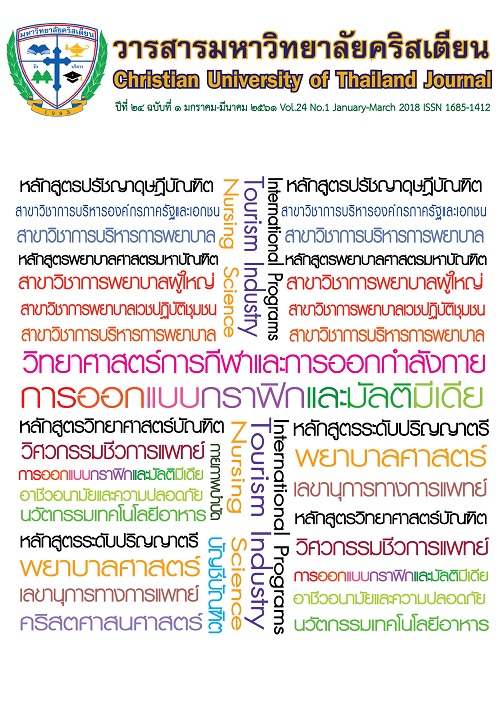รูปแบบเทคโนโลยีการประมวลผลแบบคลาวด์เพื่อการประเมินในแฟ้มสะสมงานอิเล็กทรอนิกส์
คำสำคัญ:
การประเมินอิเล็กทรอนิกส์, เทคโนโลยีการประมวลผลแบบคลาวด์, / แฟ้มสะสมงานอิเล็กทรอนิกส์บทคัดย่อ
การนำการประเมินงานแบบอิเล็กทรอนิกส์มาใช้ในปัจจุบันได้รับความนิยมแพร่หลายอันเนื่องมาจากความก้าวหน้าของอีเลิร์นนิง (E-Learning) ซึ่งเป็นโครงสร้างพื้นฐานสำคัญในการสนับสนุนการประเมินอิเล็กทรอนิกส์นอกจากการประเมินอิเล็กทรอนิกส์ในรูปแบบข้อสอบปรนัยหลายตัวเลือกแล้ว การประเมินแฟ้มสะสมงานอิเล็กทรอนิกส์ก็เป็นทางเลือกหนึ่งที่ได้รับความสนใจในด้านการศึกษาเช่นกันเนื่องจากมีข้อดีที่สามารถประเมินผลงานนักเรียนได้ตามสภาพจริง (Authentic assessment) แต่การประเมินแฟ้มสะสมงานอิเล็กทรอนิกส์นั้นแตกต่างจากการประเมินอิเล็กทรอนิกส์ในรูปแบบข้อสอบหลายตัวเลือกเพราะต้องมีการแปลงแฟ้มสะสมงานอิเล็กทรอนิกส์ ให้อยู่ในรูปแบบที่จับคู่กับเกณฑ์รูบริค (Rubric) เพื่อสร้างแบบฟอร์มการประเมินอิเล็กทรอนิกส์เสียก่อนอย่างไรก็ตามทั้งการประเมินอิเล็กทรอนิกส์และการประเมินแฟ้มสะสมงานอิเล็กทรอนิกส์เมื่อมีการใช้งานมากขึ้นทำให้พบปัญหาหลายประการ เช่น ความหลากหลายของแพลตฟอร์มของระบบและการขยายทรัพยากรเพื่อการสอบในระยะเวลาสั้นๆ เป็นต้นด้วยเหตุนี้จึงมีการแก้ปัญหาด้วยการนำเอาเทคโนโลยีการประมวลผลแบบคลาวด์ซึ่งเป็นเทคโนโลยีที่มีสมรรถนะสูงมาใช้ แต่การประมวลผลแบบคลาวด์กลับพบปัญหาการนำทรัพยากรการประมวลผล แบบคลาวด์ที่มีประสิทธิภาพสูงไปใช้งานต่ำกว่าศักยภาพของระบบที่มีอยู่ ตลอดจนการใช้งานคลาวด์เป็นเพียงแค่แหล่งเก็บข้อมูลธรรมดา ทั้งๆ ที่สามารถพัฒนาระบบสารสนเทศบนคลาวด์ให้สามารถทำงานได้แบบอัตโนมัติ บทความนี้ได้นำเสนอรูปแบบที่ช่วยนำเทคโนโลยีการประมวลผลแบบคลาวด์มาใช้ในระบบประเมินแฟ้มสะสมงานอิเล็กทรอนิกส์เพื่อให้สามารถทำงานได้อย่างมีประสิทธิภาพมากขึ้นและเป็นแนวทางให้ศึกษาวิจัยต่อไปในอนาคต
เอกสารอ้างอิง
Armbrust, M.; Fox, A.; Griffith, R.; Joseph, A.;Katz, R.; Konwinski, A.; Lee, G.; Patterson, D.; Rabkin, A.; Stoica, I. et al. (2010). A view of cloud computing. Communications of the ACM. 53(4), 50-58.
Ashton, H.S. & Thomas, R.C. (2006). Bridging the gap between assessment, learning and teaching. Proceedings of the 10th International Computer Assisted Assessment Conference. Loughborough.
Barrett, H. C. (2000). How to create your own electronic portfolio. Retrieved April 16, 2017, from Electronic Portfolios: https://electronicportfolios.org/portfolios/howto/.
Barton, J. & Collins, A. (1997). Starting Out : Designing Your Portfolio Portfolio Assessment : A Handbook for Educators. California: Addison Wesley Publishing Company.
Beevers, C. (2011). What can e-assessment do for learning and teaching? Part 1 of a draft of current and emerging practice: review by the E-Assessment Association Expert Panel. International Journal of e-Assessment. 1(2), หน้า - หน้า.
Bull, J. & McKenna, C. (2004). Blueprint for computer-aided assessment. London: Routledge.
Butcher, P.G. & Jordan, S.E. (2010). A comparison of human and computer marking of short free-text student responses. Computers & Education. (55), 489-499.
Chang, C. (2001). A study on the evaluation and effectiveness analysis of web-based learning portfolio. BJET. 32(4), 435-458.
Cole, D. J. (1998). Portfolio Across the Curriculum and Beyond. California : Corwin Press.
Dermo, J. (2007). Benefits and obstacles: factors affecting the uptake of CAA in undergraduate courses. In F. Khandia (Ed.), the 11th International Computer Assisted Assessment Conference. Loughborough: Loughborough University.
Doelitzscher,F. ;Sulistio A. ;Reich C. ; Kuijs H. ; & Wolf D. ( 2011). Private cloud for collaboration and e-learning services. Computing. 91(1), 23-42.
EBRC. (2017, March 13). Cloud service models. [Online]. Retrieved https://www.ebrc.com/cloud/Cloud-service-models.
Elbow, P., & Belanoff, P. (1986). Portfolios as a substitute for proficiency examinations. College Composition and Communication. 37(3), 336-339.
Gipps, C. V. (2005). What is the role for ICT?based assessment in universities?. Studies in Higher Education. 30(2), 171-180.
Ho,J.H.;Luo, M.Y. , & Yang, C.S. (2007). Building a scalable digital learning system on server clusters. J. Inf. Sci. Eng. 23(3) : 803-819.
JISC. (2006). JISC. [Online]. Retrieved March 11, 2017, from https://www.jisc.ac.uk/ uploaded_documents/eAssess-Glossary-Extendedv1-01.pdf.
JISC. (2010). Effective assessment in a digital age :a guide to technology-enhanced assessment and feedback. [Online]. Retrieved March 13, 2017, from https://www.jisc.ac.uk/publications/programmerelated/2010/digiassess.aspx.
Jordan, S. & Butcher, P. (2010). Using e-assessment to support distance learners of science. Physics Community and Cooperation: Selected Contributions from the GIREP-EPEC and PHEC 2009 International Conference (ed. D. Raine, C. Hurkett and L. Rogers). Leicester: Lula/The Centre for Interdisciplinary Science.
Kankaew, V., & Wannapiroon, P. (2015). System Analysis of Virtual Team in Cloud Computing to Enhance Teamwork Skills of Undergraduate Students. Procedia-Social and Behavioral Sciences. (174) : 4096-4102.
Mackenzie, D. (2003). Assessment for e-learning: what are the features of an ideal e-assessment system?. Computer-Assisted Assessment Conference, University of the 7th International. University of Loughborough. Retrieved from Computer-Assisted Assessment Conference, University of Loughborough.
Mark Townsend; Jeff Bond & Jim Zimmermann. (2013, September). White Paper: Learning in the Cloud:10 Factors to Consider. Retrieved December 24, 2016, from : https://www.skillsoft.com/assets/white-papers/whitepaper_cloud_learning.pdf.
Masud, M. and Huang, X.,. (2012). A novel approach for adopting cloud-based e-learning system. Computer and Information Science (ICIS), 2012 IEEE/ACIS 11th International Conference.
Mell, P. & Grance, T. (2011). National Insitute of Standard and Technology. [Online]. Retrieved December 12, 2016, from https://dx.doi.org/10.6028/NIST.SP.800-145.
Meyer, E., Abrami, P. C., Wade, C. A., Aslan, O., & Deault, L. (2010). "Improving literacy and metacognition with electronic portfolios: Teaching and learning with ePEARL". Computers & Education. 55(1) : 84-91.
Nookhong, J., & Wannapiroon, P. (2015). Development of collaborative learning using case-based learning via cloud technology and social media for enhancing problem-solving skills and ICT literacy within undergraduate students. Procedia-Social and Behavior Science. (174) : 2096-2101
Paulson, F., Paulson, P. & Mercer, C. (1991). What makes a portfolio a portfolio? . Educational Leadership. 48(5) : 60-63.
Wang, L.;Tao, J.;Kunze, M.;Castellanos, A.;,Kramer, D.; and Karl, W. (2008). Scientific cloud computing: Early definition and experience. 2008. HPCC'08. 10th IEEE International Conference on . IEEE.
Yoosomboon, S., & Wannapiroon, P. (2015). "Development of a Challenge Based Learning Model via Cloud Technology and Social Media for Enhancing Information Management Skills". Procedia-Social and Behavioral Sciences.(174) : 2102-2107)



